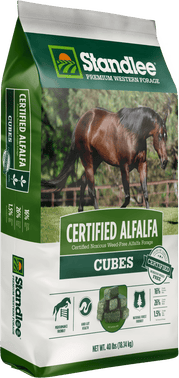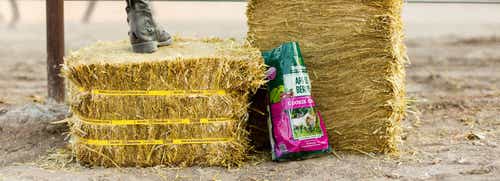
How to Avoid High NSC Intake for Horses in the Spring
Research has shown that pasture-induced laminitis occurs at times of rapid grass growth, which happens to be in the spring particularly. Therefore, we must carefully manage pasture turnout and forage intake in horses and ponies that are at risk for developing laminitis or who are currently affected. We also understand that horses suffering from insulin resistance (IR) and/or Cushing’s (pituitary pars intermedia dysfunction or PPID), as well as horses and ponies with the ‘‘easy keeper’’ phenotype (that are often overweight or obese) and may be persistently hyperinsulinemic, should also be managed carefully with regard to their carbohydrate intake.
Here are some strategies for avoiding high Non-Structural Carbohydrates (NSC) intake by horses and ponies at risk for pasture laminitis:
- Animals predisposed to laminitis should be denied access to grass pastures, particularly during the spring.
- At other times of the year, limit the amount of turnout time each day (e.g., 1–3 hours) and turn animals out late at night (after 10:00 pm) or early in the morning, removing them from pasture by mid-morning at the latest (before 10:00 am), because NSC levels are likely to be at their lowest late at night through the early morning.
- Alternatively, limit the size of the available pasture by use of temporary fencing to create small paddocks and use a grazing muzzle.
- Avoid pastures that have not been properly managed by regular grazing or cutting, because mature stemmy grasses may contain more fructan (it is stored in the stem).
- Do not allow horses out onto stressed pasture, i.e. drought, cold temperatures, poor soil nutrition, as these plants will not be actively growing, and therefore will store all of their energy (sugars and fructan) in the plant.
- If utilizing a dry lot, create a two-foot buffer so the horse cannot reach under the fence to consume stressed grasses.
- Always a great reminder, NSC is Water Soluble Carbohydrates (WSC) plus starch and WSC is sugar plus fructan.
- Sugar is sometimes referred to as Ethanol Soluble Carbohydrates (ESC).
The benefit of purchasing a bagged forage product, is they come with a guaranteed analysis and an ingredients list and, therefore, we can assume a level of consistency between bags. Horses are routine animals, and sudden dietary changes can cause digestive upset, such as colic. Spring grass is also very high in moisture content; therefore, the quantity that needs to be consumed is very high to achieve 2% of BW as dry hay.
If your horse is underweight, Standlee Premium Alfalfa Products are an ideal forage solution to increase calories while maintaining low NCS. If your horse is overweight, Standlee Premium Teff Grass Pellets are the ideal forage solution limits calorie intake and NSC. Standlee offers a variety of high-quality forage solutions that remain consistent throughout the year and are widely available across the country. These forage products are of great value in maintaining your horse’s digestive health.
To learn more about spring pasture turnout, including duration of access to pastures for particular horses, download our latest Nutritional Paper - Spring Pasture Turnout – What We need to Know.
By Dr. Tania Cubitt
Standlee Nutritional Expert - Performance Horse Nutrition












